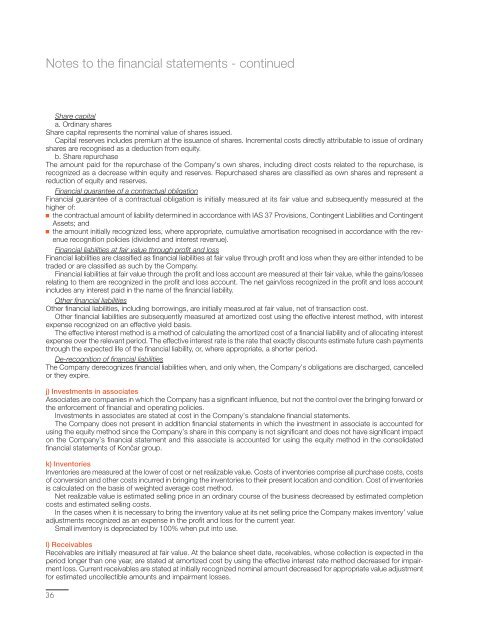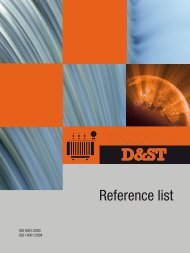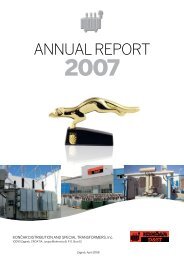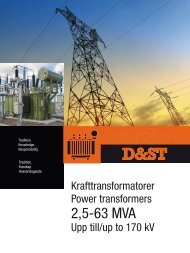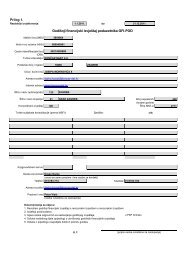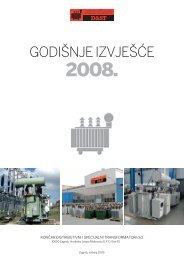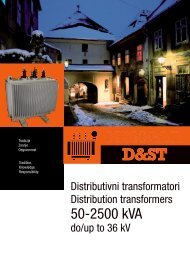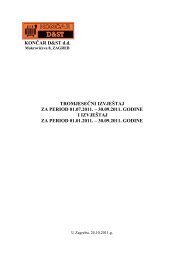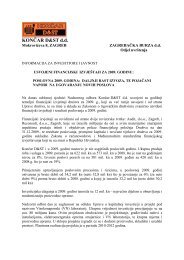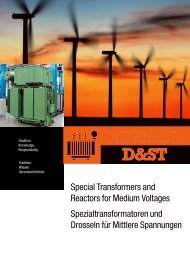Annual Report - KonÄar Distribution and Special Transformers Inc.
Annual Report - KonÄar Distribution and Special Transformers Inc.
Annual Report - KonÄar Distribution and Special Transformers Inc.
Create successful ePaper yourself
Turn your PDF publications into a flip-book with our unique Google optimized e-Paper software.
Notes to the financial statements - continued<br />
Share capital<br />
a. Ordinary shares<br />
Share capital represents the nominal value of shares issued.<br />
Capital reserves includes premium at the issuance of shares. <strong>Inc</strong>remental costs directly attributable to issue of ordinary<br />
shares are recognised as a deduction from equity.<br />
b. Share repurchase<br />
The amount paid for the repurchase of the Company’s own shares, including direct costs related to the repurchase, is<br />
recognized as a decrease within equity <strong>and</strong> reserves. Repurchased shares are classified as own shares <strong>and</strong> represent a<br />
reduction of equity <strong>and</strong> reserves.<br />
Financial guarantee of a contractual obligation<br />
Financial guarantee of a contractual obligation is initially measured at its fair value <strong>and</strong> subsequently measured at the<br />
higher of:<br />
the contractual amount of liability determined in accordance with IAS 37 Provisions, Contingent Liabilities <strong>and</strong> Contingent<br />
Assets; <strong>and</strong><br />
the amount initially recognized less, where appropriate, cumulative amortisation recognised in accordance with the revenue<br />
recognition policies (dividend <strong>and</strong> interest revenue).<br />
Financial liabilities at fair value through profit <strong>and</strong> loss<br />
Financial liabilities are classified as financial liabilities at fair value through profit <strong>and</strong> loss when they are either intended to be<br />
traded or are classified as such by the Company.<br />
Financial liabilities at fair value through the profit <strong>and</strong> loss account are measured at their fair value, while the gains/losses<br />
relating to them are recognized in the profit <strong>and</strong> loss account. The net gain/loss recognized in the profit <strong>and</strong> loss account<br />
includes any interest paid in the name of the financial liability.<br />
Other financial liabilities<br />
Other financial liabilities, including borrowings, are initially measured at fair value, net of transaction cost.<br />
Other financial liabilities are subsequently measured at amortized cost using the effective interest method, with interest<br />
expense recognized on an effective yield basis.<br />
The effective interest method is a method of calculating the amortized cost of a financial liability <strong>and</strong> of allocating interest<br />
expense over the relevant period. The effective interest rate is the rate that exactly discounts estimate future cash payments<br />
through the expected life of the financial liability, or, where appropriate, a shorter period.<br />
De-recognition of financial liabilities<br />
The Company derecognizes financial liabilities when, <strong>and</strong> only when, the Company’s obligations are discharged, cancelled<br />
or they expire.<br />
j) Investments in associates<br />
Associates are companies in which the Company has a significant influence, but not the control over the bringing forward or<br />
the enforcement of financial <strong>and</strong> operating policies.<br />
Investments in associates are stated at cost in the Company’s st<strong>and</strong>alone financial statements.<br />
The Company does not present in addition financial statements in which the investment in associate is accounted for<br />
using the equity method since the Company’s share in this company is not significant <strong>and</strong> does not have significant impact<br />
on the Company’s financial statement <strong>and</strong> this associate is accounted for using the equity method in the consolidated<br />
financial statements of KonËar group.<br />
k) Inventories<br />
Inventories are measured at the lower of cost or net realizable value. Costs of inventories comprise all purchase costs, costs<br />
of conversion <strong>and</strong> other costs incurred in bringing the inventories to their present location <strong>and</strong> condition. Cost of inventories<br />
is calculated on the basis of weighted average cost method.<br />
Net realizable value is estimated selling price in an ordinary course of the business decreased by estimated completion<br />
costs <strong>and</strong> estimated selling costs.<br />
In the cases when it is necessary to bring the inventory value at its net selling price the Company makes inventory’ value<br />
adjustments recognized as an expense in the profit <strong>and</strong> loss for the current year.<br />
Small inventory is depreciated by 100% when put into use.<br />
l) Receivables<br />
Receivables are initially measured at fair value. At the balance sheet date, receivables, whose collection is expected in the<br />
period longer than one year, are stated at amortized cost by using the effective interest rate method decreased for impairment<br />
loss. Current receivables are stated at initially recognized nominal amount decreased for appropriate value adjustment<br />
for estimated uncollectible amounts <strong>and</strong> impairment losses.<br />
36


